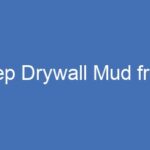If you’ve recently moved into a new house or had rooms in your home renovated, you might have experienced the frustration of seeing once pristine drywall develop unsightly cracks and screws popping through the paint.
While it’s tempting to place blame on the construction work, the causes of drywall issues are often more complex than they seem. In this comprehensive guide, we will delve into the various reasons behind drywall cracks and screws popping, shedding light on the factors that go beyond just the quality of the installation process.
The Vulnerable Drywall Seams
One key point to understand is that the seam where two sheets of drywall meet creates a vulnerable point in the wall. Drywall tapers employ mud and tape to reinforce this joint, with the tape acting like a band-aid for the fault line. Layers of drywall mud are subsequently added to ensure a seamless transition with the rest of the wall.
However, when a house settles or walls experience movement, cracks can occur. These cracks can be attributed to either structural weakness in the joint or unexpected movement that exceeds initial expectations.
The Role of Drywall Mud
A critical factor contributing to drywall cracks is the choice of drywall mud during the taping process. It’s essential to select the right type of drywall mud for the specific application. Some drywall mud variants offer superior adhesion and should be used when taping drywall, while others are better suited for finishing.
Certain products are designed exclusively for second or third coats. Selecting the appropriate type of drywall mud is crucial to prevent cracking.
Mesh Tape vs. Paper Tape
Debates among drywall tapers about whether to use mesh tape or paper tape for drywall taping are common. Some argue that mesh tape should never be used due to its perceived weakness compared to paper tape. However, proponents of mesh tape assert its reliability when combined with quick-set drywall mud.
The key is to ensure proper bedding of mesh tape with quick-set drywall mud to avoid subsequent drywall cracks. Using an all-purpose or lightweight drywall mud with mesh tape often leads to problems.
Understanding Drywall Corner Bead
Drywall corner bead installation can also be a source of cracks, primarily due to improper installation. Different types of corner beads have specific requirements for installation. For instance, vinyl corner bead can be attached with spray adhesive, but incorrect adhesive selection or insufficient usage can result in cracking during building settlement.
When using staples for vinyl corner bead installation, improper techniques can lead to cracking. In the case of metal corner bead, an adequate number of screws or nails is required to provide sufficient strength and prevent cracking during settling.
In cases where absolute strength and crack prevention are paramount, the paper-faced (“tape-on”) corner bead installed with an all-purpose drywall compound is a reliable choice.
Nail and Screw Pops
Nail pops are another common issue in drywall, typically occurring within the first year after installation. These pops happen when the head of a nail protrudes through the drywall’s paper surface, causing paint separation. To mitigate this problem, drywall hangers often use construction adhesive on the studs and secure the drywall with nails or screws, reducing the likelihood of nail pops. However, this method isn’t foolproof.
Engineering and Design Factors
It’s essential to recognize that not all drywall cracking can be attributed to installation methods. Factors such as engineering deficiencies in building design can lead to significant drywall cracks. Engineers anticipate settling and movement in buildings over time and design solutions to mitigate these issues. Well-placed expansion joints are a prime example of engineering solutions to accommodate expected building movement.
High-Stress Areas
Cracks in drywall typically appear in high-stress areas, such as above doorways, windows, or over long-spanning beams. When a building undergoes even slight movement, these load-bearing zones experience extreme pressure, potentially leading to cracks. The causes of building movement vary and cannot always be eliminated. However, proper consideration of building settling during the design phase can help manage it effectively.



Why Drywall Seams Crack: Understanding the Common Culprits and How to Prevent Them
If you’ve ever walked into a room and noticed unsightly cracks in your drywall, you’re not alone. Drywall seam cracks can be a frustrating issue for homeowners, but they’re not an uncommon occurrence. In this comprehensive guide, we’ll delve into the world of drywall and uncover the reasons behind these frustrating cracks. We’ll also provide you with tips and tricks to prevent them from happening in the first place. Let’s get started!
The Basics of Drywall
Before we dive into the causes of drywall seam cracks, let’s establish a fundamental understanding of what drywall is. Drywall, also known as gypsum board or plasterboard, is a common building material used for interior walls and ceilings. It’s composed of a core of gypsum plaster, enclosed between layers of paper, creating a sturdy yet relatively lightweight surface for finishing.
The Role of Drywall Seams
Drywall panels are rarely large enough to cover an entire wall or ceiling, which is where seams come into play. Seams are the junctions between two adjacent drywall panels. They are essential for a smooth, continuous surface and play a crucial role in the structural integrity of the wall.
The Types of Drywall Seams
There are two main types of drywall seams: tapered and butt seams. Tapered seams are used for joints between two tapered edges of drywall panels, allowing for a more gradual transition. Butt seams, on the other hand, involve two square-cut panel edges meeting, which can be more challenging to hide.
Why Drywall Seams Crack
- Normal Shrinkage and Settlement
One common reason for drywall seam cracks is the natural settling and shrinkage of a building. As your house settles over time, it can put stress on the drywall, leading to cracks along the seams. This is a normal part of a house’s aging process. - Moisture-Related Issues
Moisture is another major factor in the development of drywall seam cracks. Excess moisture in the air can seep into the drywall, causing it to expand and contract. This constant movement can create stress on the seams, eventually leading to cracks. - Temperature Fluctuations
Just as with moisture, extreme temperature fluctuations can cause your drywall to expand and contract. This repeated expansion and contraction can weaken the seams, making them more susceptible to cracking. - Poor Installation
Improper installation is a leading cause of drywall seam cracks. If the seams are not taped and mudded correctly or if the drywall is not properly screwed or nailed to the studs, cracks are more likely to develop. - Low-Quality Materials
The quality of the materials used can also contribute to seam cracking. Low-quality drywall or joint compound can be more prone to cracking, especially when subjected to the stresses of settling, moisture, and temperature changes. - Structural Issues
Structural problems within your home, such as a shifting foundation or unstable framing, can lead to stress on the drywall seams. Addressing these underlying issues is crucial to prevent recurring seam cracks. - Impact Damage
Accidental impacts, whether from furniture, doorknobs, or other objects, can cause visible damage to drywall seams. This type of damage is usually localized and can be repaired more easily than cracks caused by other factors. - Inadequate Drywall Reinforcement
Some areas, like corners and edges, require additional reinforcement to prevent cracking. Without proper reinforcement, these high-stress areas are more prone to developing cracks. - Settling of New Construction
If you’ve recently built or renovated your home, it’s common for the drywall to settle in the first year. This settling can lead to initial seam cracks that may need repair after the settling period. - Seasonal Changes
Seasonal changes, like the shift from humid summers to dry winters, can affect the moisture content of your home’s structure. These fluctuations can stress the drywall seams, leading to cracks.
How to Prevent Drywall Seam Cracks
Now that we’ve explored the various causes of drywall seam cracks, let’s discuss how you can prevent them. Proper installation, regular maintenance, and addressing structural issues are key steps to keeping your drywall seams intact.
Wrapping Up
In summary, drywall cracks and screw pops are multifaceted issues with various causes. While some may be attributed to construction techniques, many are beyond the control of drywall finishers. It’s essential to choose the right materials, techniques, and adhere to best practices during the installation process to minimize the risk of cracks. In cases of significant cracking, especially in non-high-stress areas, it may be advisable to explore other solutions to prevent future damage. Effective drywall techniques can significantly reduce the occurrence of cracks and nail pops.
FAQs – Drywall Seam Cracks
Yes, minor cracks can be repaired with some DIY skills and the right materials. However, for significant or recurring cracks, it’s best to consult a professional.
To prevent moisture-related cracks, ensure good ventilation in your home, use a dehumidifier if necessary, and seal any gaps or leaks that allow moisture to enter.
High-quality drywall, such as mold-resistant or impact-resistant variants, can be more resistant to cracking. Investing in better materials can be a preventive measure.
Yes, you can paint over cracked seams after repairing them. However, it’s crucial to address the cracks first, as painting alone won’t solve the underlying issue.
Regularly inspect your drywall during seasonal changes and after significant home events like renovations. Promptly addressing any cracks can prevent them from worsening.
tag: # Drywall Cracks and Screws Popping







